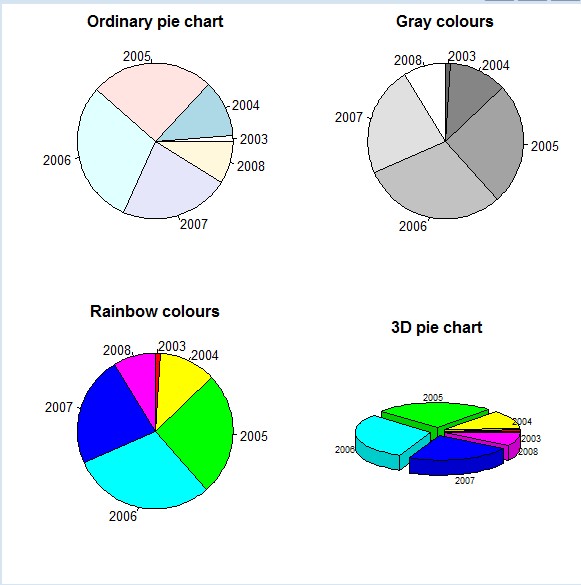BirdFluCases.txt1 饼图
1.1 载入数据
setwd("E:/R/R-beginer-guide/data/RBook")
BFCases <- read.table(file="BirdFluCases.txt",header=TRUE)
names(BFCases)
str(BFCases)
> setwd("E:/R/R-beginer-guide/data/RBook")
> BFCases <- read.table(file="BirdFluCases.txt",header=TRUE)
错误于make.names(col.names, unique = TRUE) : 多字节字符串8有错
> names(BFCases)
错误: 找不到对象'BFCases'
> str(BFCases)
错误于str(BFCases) : 找不到对象'BFCases'
>打开BirdFluCases.txt文件,发现有个’?‘ 删除即可
再次运行载入脚本
> setwd("E:/R/R-beginer-guide/data/RBook")
> BFCases <- read.table(file="BirdFluCases.txt",header=TRUE)
> names(BFCases)
[1] "Year" "Azerbaijan" "Bangladesh" "Cambodia" "China"
[6] "Djibouti" "Egypt" "Indonesia" "Iraq" "LaoPDR"
[11] "Myanmar" "Nigeria" "Pakistan" "Thailand" "Turkey"
[16] "VietNam"
> str(BFCases)
'data.frame': 6 obs. of 16 variables:
$ Year : int 2003 2004 2005 2006 2007 2008
$ Azerbaijan: int 0 0 0 8 0 0
$ Bangladesh: int 0 0 0 0 0 1
$ Cambodia : int 0 0 4 2 1 0
$ China : int 1 0 8 13 5 3
$ Djibouti : int 0 0 0 1 0 0
$ Egypt : int 0 0 0 18 25 7
$ Indonesia : int 0 0 20 55 42 18
$ Iraq : int 0 0 0 3 0 0
$ LaoPDR : int 0 0 0 0 2 0
$ Myanmar : int 0 0 0 0 1 0
$ Nigeria : int 0 0 0 0 1 0
$ Pakistan : int 0 0 0 0 3 0
$ Thailand : int 0 17 5 3 0 0
$ Turkey : int 0 0 0 12 0 0
$ VietNam : int 3 29 61 0 8 5
>
Cases <- rowSums(BFCases[,2:16])
names(Cases) <- BFCases[,1]
Cases
par(mfrow=c(2,2),mar=c(3,2,2,1))
pie(Cases,main="Ordinary pie chart")
pie(Cases,col=gray(seq(0.4,1.0,length=6)),clockwise=TRUE,main="Gray colours")
pie(Cases,col=rainbow(6),clockwise=TRUE,main="Rainbow colours")
library(plotrix)
pie3D(Cases,labels=names(Cases),explode=0.1,main="3D pie chart",labelcex=0.6)
效果图:

par函数:mfrowc(2,2)表示生成四个面板 mar用来调整四侧边缘线的数目
clockwise=TRUE 表示按照瞬时间排时间
2 条形图
载入数据
BFDeaths <- read.table(file="BirdFluDeaths.txt",header=TRUE)
Deaths <- rowSums(BFDeaths[,2:16])
names(Deaths) <- BFDeaths[,1]
Deaths
par(mfrow = c(2,2),mar = c(3,3,2,1))
barplot(Cases,main="Bird Flu cases")
Counts <- cbind(Cases,Deaths)
barplot(Counts)
barplot(t(Counts),col = gray(c(0.5,1)))
barplot(t(Counts),beside = TRUE)

3 显示均值和标准差的条形图
载入数据
Benthic <- read.table(file="RIKZ2.txt",header = TRUE)
Bent.M <- tapply(Benthic$Richness,INDEX=Benthic$Beach,FUN=mean)
Bent.sd <- tapply(Benthic$Richness,INDEX=Benthic$Beach,FUN=sd)
MSD <- cbind(Bent.M,Bent.sd)
MSD
图形显示代码
barplot(Bent.M)
barplot(Bent.M,xlab="Beach",ylim=c(0,20),ylab="Richness",col=rainbow(9))
bp <- barplot(Bent.M,xlab="Beach",ylim=c(0,20),ylab="Richness",col=rainbow(9))
arrows(bp,Bent.M,bp,Bent.M+Bent.sd,lwd=1.5,angle=90,length=0.1)
box()
Benth.le <- tapply(Benthic$Richness,INDEX=Benthic$Beach,FUN=length)
Benth.se <- Bent.sd / sqrt(Benth.le)
stripchart(Benthic$Richness ~ Benthic$Beach,vert = TRUE,pch=1,method="jitter",
jit=0.05,xlab="Beach",ylab="Richness")
points(1:9,Bent.M,pch=16,cex=1.5)
arrows(1:9,Bent.M,1:9,Bent.M+Benth.se,lwd = 1.5,angle = 90,length = 0.1)
arrows(1:9,Bent.M,1:9,Bent.M-Benth.se,lwd = 1.5,angle = 90,length = 0.1)盒形图
载入数据
Owls <- read.table("Owls.txt",header = TRUE)
boxplot(Owls$NegPerChick,main="Negotiation per chick")描绘图形
par(mfrow = c(2,2),mar = c(3,3,2,1))
boxplot(NegPerChick ~ SexParent,data = Owls)
boxplot(NegPerChick ~ FoodTreatment,data = Owls)
boxplot(NegPerChick ~ SexParent * FoodTreatment,data = Owls)
boxplot(NegPerChick ~ SexParent * FoodTreatment,names = c("F/Dep","M/Dep","F/Sat","M/Sat"),data = Owls)另外一个盒形图
代码
par(mar = c(2,2,3,3))
boxplot(NegPerChick ~ Nest,data = Owls,axes = FALSE,ylim =c (-3,8.5))
axis(2,at = c(0,2,4,6,8))
text(x=1:27,y = -2,labels=levels(Owls$Nest),cex=0.75,srt = 65)
Deer <- read.table(file="Deer.txt",header = TRUE,fill = TRUE)
dotchart(Deer$LCT,xlab="Length (cm)",ylab=" Observation number")
Isna <- is.na(Deer$Sex)
dotchart(Deer$LCT[!Isna],groups=factor(Deer$Sex[!Isna]),xlab="Length(cm)",
ylab="Observation number grouped by sex)

另外一个添加均值的例子
Benthic <- read.table(file="RIKZ2.txt",header = TRUE)
Benthic$fBeach <- factor(Benthic$Beach)
par(mfrow = c(1,2))
dotchart(Benthic$Richness,groups = Benthic$fBeach,xlab = "Richness",ylab="Beach")
Bent.M <- tapply(Benthic$Richness,Benthic$Beach,FUN=mean)
dotchart(Benthic$Richness,groups = Benthic$fBeach,gdata=Bent.M,
gpch=19,xlab="Richness", ylab="Beach")
legend("bottomright",c("values","mean"),pch=c(1,19),bg="white") 
plot实战1
plot(y = Benthic$Richness,x = Benthic$NAP,xlab="Mean high tide (m)",
ylab="Species richness",main="Benthic data")
M0 <- lm(Richness ~ NAP ,data = Benthic)
abline(M0)
plot(y = Benthic$Richness,x = Benthic$NAP,
xlab="Mean high tide (m)",ylab="Species richness",
main="Benthic data",xlim=c(-3,3),ylim=c(0,20))
plot(y = Benthic$Richness,x = Benthic$NAP, type="n",axes=FALSE ,
xlab="Mean high tide (m)",ylab="Species richness")
points(y = Benthic$Richness,x = Benthic$NAP)
plot(y = Benthic$Richness,x = Benthic$NAP, type="n",axes=FALSE ,
xlab="Mean high tide (m)",ylab="Species richness",
xlim = c(-1.75,2),ylim = c(0,20))
points(y = Benthic$Richness,x = Benthic$NAP)
axis(2,at = c(0,10,20),tcl = 1)
axis(1,at = c(-1.75,0,2),labels=c("Sea","Water line","Dunes"))
Birds <- read.table(file="loyn.txt",header =TRUE)
Birds$LOGAREA <- log10(Birds$AREA)
plot(x=Birds$LOGAREA,y=Birds$ABUND,xlab="Log transformed area",
ylab="Bird adbundance")
M0 <- lm(ABUND~LOGAREA+GRAZE,data=Birds)
summary(M0)
LAR <- seq(from=-1,to =3,by =1)
ABUND1 <- 15.7+7.2*LAR
ABUND2 <- 16.1+7.2*LAR
ABUND3 <- 15.5+7.2*LAR
ABUND4 <- 14.1+7.2*LAR
ABUND5 <- 3.8+7.2*LAR
lines(LAR,ABUND1,lty = 1,lwd=1,col=1)
lines(LAR,ABUND2,lty = 2,lwd=2,col=2)
lines(LAR,ABUND3,lty = 3,lwd=3,col=3)
lines(LAR,ABUND4,lty = 4,lwd=4,col=4)
lines(LAR,ABUND5,lty = 5,lwd=5,col=5)
legend.txt <- c("Graze 1","Graze 2","Graze 3","Graze 4","Graze 5")
legend("topleft",legend=legend.txt,
col=c(1,2,3,4,5),
lty=c(1,2,3,4,5),
lwd=c(1,2,3,4,5),
bty="o",cex=0.8)
Whales <- read.table(file="TeethNitrogen.txt",
header=TRUE)
N.Moby <- Whales$X15N[Whales$Tooth=="Moby"]
Age.Moby <- Whales$Age[Whales$Tooth=="Moby"]
plot(x=Age.Moby,y=N.Moby,xlab="Age",ylab=expression(paste(delta^{15},"N")))























 2703
2703

 被折叠的 条评论
为什么被折叠?
被折叠的 条评论
为什么被折叠?








